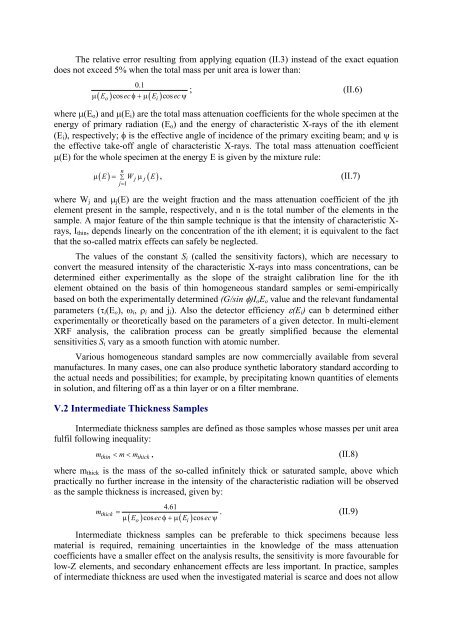X-Ray Fluorescence Analytical Techniques - CNSTN : Centre ...
X-Ray Fluorescence Analytical Techniques - CNSTN : Centre ...
X-Ray Fluorescence Analytical Techniques - CNSTN : Centre ...
You also want an ePaper? Increase the reach of your titles
YUMPU automatically turns print PDFs into web optimized ePapers that Google loves.
The relative error resulting from applying equation (II.3) instead of the exact equation<br />
does not exceed 5% when the total mass per unit area is lower than:<br />
0.1<br />
( ) ( )<br />
µ E cos ecφ+µ E cos ecψ<br />
o i<br />
; (II.6)<br />
where µ(Eo) and µ(Ei) are the total mass attenuation coefficients for the whole specimen at the<br />
energy of primary radiation (Eo) and the energy of characteristic X-rays of the ith element<br />
(Ei), respectively; φ is the effective angle of incidence of the primary exciting beam; and ψ is<br />
the effective take-off angle of characteristic X-rays. The total mass attenuation coefficient<br />
µ(E) for the whole specimen at the energy E is given by the mixture rule:<br />
n<br />
µ ( E) = ∑ Wj µ j ( E)<br />
, (II.7)<br />
j=<br />
1<br />
where Wj and µj(E) are the weight fraction and the mass attenuation coefficient of the jth<br />
element present in the sample, respectively, and n is the total number of the elements in the<br />
sample. A major feature of the thin sample technique is that the intensity of characteristic Xrays,<br />
Ithin, depends linearly on the concentration of the ith element; it is equivalent to the fact<br />
that the so-called matrix effects can safely be neglected.<br />
The values of the constant Si (called the sensitivity factors), which are necessary to<br />
convert the measured intensity of the characteristic X-rays into mass concentrations, can be<br />
determined either experimentally as the slope of the straight calibration line for the ith<br />
element obtained on the basis of thin homogeneous standard samples or semi-empirically<br />
based on both the experimentally determined (G/sin φ)IoEo value and the relevant fundamental<br />
parameters (τi(Eo), ωi, ρi and ji). Also the detector efficiency ε(Ei) can b determined either<br />
experimentally or theoretically based on the parameters of a given detector. In multi-element<br />
XRF analysis, the calibration process can be greatly simplified because the elemental<br />
sensitivities Si vary as a smooth function with atomic number.<br />
Various homogeneous standard samples are now commercially available from several<br />
manufactures. In many cases, one can also produce synthetic laboratory standard according to<br />
the actual needs and possibilities; for example, by precipitating known quantities of elements<br />
in solution, and filtering off as a thin layer or on a filter membrane.<br />
V.2 Intermediate Thickness Samples<br />
Intermediate thickness samples are defined as those samples whose masses per unit area<br />
fulfil following inequality:<br />
mthin < m< mthick<br />
, (II.8)<br />
where mthick is the mass of the so-called infinitely thick or saturated sample, above which<br />
practically no further increase in the intensity of the characteristic radiation will be observed<br />
as the sample thickness is increased, given by:<br />
mthick<br />
4.61<br />
= . (II.9)<br />
µ E cos ecφ+µ E cos ecψ<br />
( ) ( )<br />
o i<br />
Intermediate thickness samples can be preferable to thick specimens because less<br />
material is required, remaining uncertainties in the knowledge of the mass attenuation<br />
coefficients have a smaller effect on the analysis results, the sensitivity is more favourable for<br />
low-Z elements, and secondary enhancement effects are less important. In practice, samples<br />
of intermediate thickness are used when the investigated material is scarce and does not allow


